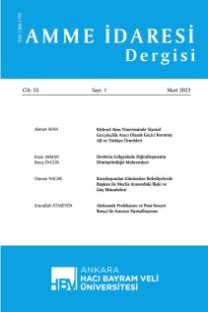Yolsuzluk ve Sağlık Hizmetleri
Corruption and Health Care Services
___
- Acemoğlu, Daron ve Thierry, Verdier (2000), "The Choice Between Market Failures and Corruption", American Economic Review, Vol. 90 (March 2000), s. 194-211.
- Adaman, Fikret - Çarkoğlu, Ali - Şenatalar, Burhan (2001), Corruption in Turkey: Results of Diagnostic Household Survey, February 2001. Türkiye Ekonomik ve Sosyal Etüdler Vakfı (TESEV), İstanbul, http://www.tesev.org.tr Erişim (10.05.2003).
- Adaman, Fikret - Çarkoğlu, Ali - Şenatalar, Burhan (2001a), Hanehalkın Gözünde Türkiye'de Yolsuzluğun Nedenleri ve Önlenmesine İlişkin Öneriler, Türkiye Ekonomik ve Sosyal Etüdler Vakfı (TESEV), 2001, TESEV Yayınları No.24, İstanbul.
- Al-Marhubi, Fahim A. (2000), "Corruption and Inflation", Economics Letters, Vol. 66, s. 199-202.
- Bearse, P. - Glomm, G. - Janeba, E (2000), "Why Poor Countires Realy Mostly on Redistribution In-kind", Journal of Public Economics, Vol. 75, 2000, s. 463-481.
- Belli, Paolo (2002), Formal and Informal Household Spending on Health: A Multicountry Study in Central and Eastern Europe- Draft Report, Harvard School of Public Health Central and Eastern European Health Network, USA.
- Ensor, Tim (2003), "Informal Payments for Health Care in Transition Ecomomicies", Social Science and Medicine, Article in pres. 2003. http://www.sciencedirect.com (01.06.2003).
- Galtung, Fredrik (2003) "2002 Bribe Payers Index", Global Corruption Report 2003 Transparency International, s. 266-269. www.globalcorruptionreport.org. (01.05.2003).
- Gray, Cheryl W. ve Kaufmann, Daniel (March 1998), "Corruption and Development", Finance and Development, March 1998 Issue, s. 7-10.
- Gupta, Sanjeev - Davoodi, Hamid - Tiongson, Erwin (June 2000), Corruption and the Provision of Health Care and Education Services, IMF Working Papers. International Monetary Fund, USA.
- Haulikovâ, Lucia (2003) "Faces of Corruption In Slovakia I.--Chapter 2. Corruption In Particular Areas of Public Sector", http://www.transparencv.sk/english (10.05.2003).
- Haulikovâ, Lucia (2003), "Faces of Corruption In Slovakia I.", http://www.transparency.sk/english (10.05.2003).
- Huberts, J.C. (1998), "What Can Be Done Aganist Public Corruption and Fraud: Expert Views on Strategies to Protect Public Integrity", Crime, Law and Social Change, Vol. 29, ss. 209-224.
- Lambsdorff, Johann Graff (2003), "2002 Corruption Perception Index", Global Corruption Report 2003, Transparency International, s.262-266. www.globalcorruptionreport.org (01.05.2003).
- Kurtuluş, Erciş (1999), "1999 Uluslararası Yolsuzluk Algılama Endeksleri ve Türkiye'nin Durumu", Maliye Yazıları Dergisi, 15 Ekim 1999 tarihli sayısı. http://www.saydamlik.org/turkce.html (10.05.2003).
- Martiny, Anke (2000), "The Lack of Transparency in the Health Care Sector Squandered Resources, Improper Usage, Deception - Gateways to Corruption". Transparency International Working Paper, http://www.transparency.org/workingjapers (10.05.2003).
- Mauro, Paolo (1998), "Corruption and the Composition of Government Expenditure", Journal of Public Economics, Vol. 69 s. 263-279.
- Mwaffisi, MJ. (10-15 Ekim 1999) Corruption In The Health Sector. The 9th International Anti-Corruption Conference, Durban, South Africa, (www.tranparencv.org-( 10.01.2003).
- Ofori-Atta, Angela Lamensdorf ve Gadzekpo, Audrey, (10-15 Ekim 1999), The Cost of Corruption in Health Institutions. The 9th International Anti-Corruption Conference, Durban, South Africa, http://www.transparencv.org/iacc/9thiacc/papers (10.01.2003).
- Sayek, Füsun (2003) "Anestezisiz Neşter Operasyonu", Türk Dünyası, 15 Mayıs 2003, Sayı: 105, Türk Tabipleri Birliği Yayın organı. http://www.ttb.org.tr/TD105/7.php3 (01.06.2003).
- Tanzi, Vito (1998), "Corruption Around the World", International Monetary Fund Staff Papers, Vol. 45, No. 4, s. 559-594.
- Treisman, Daniel (2000), "The Causes of Corruption: A Cross-national Study", Journal of Public Economics, Vol. 76, s. 399-457.
- Tosun, Umur M. (2001), "Yolsuzluk Olgusuna Yönelik Amprik Çalışmalar Üzerine Notlar", Hacettepe Üniversitesi İktisadi ve İdari Bilimler Fakültesi Dergisi, Cilt 19, Sayı 2, ss. 97-122.
- Wolkers, Marie (2003), "National Sırveys on Corruption in Francophone Africa", Global Corruption Report 2003, Transparency International s. 269. (www.globalcorruptionreport.org (10.05.2003).
- (http://www.unibas.ch/wwz/wifor/staff/bw/survey/index.html).
- ISSN: 1300-1795
- Yayın Aralığı: 4
- Başlangıç: 1968
- Yayıncı: -
Yolsuzluk ve Sağlık Hizmetleri
ISO 9000 Belgesi Olan Örgütlerde Çalışanların Kurumsallaşmaya İlişkin Algıları
Bulgaristan Cumhuriyeti Eğitim Sistemi: Yapı ve Yönetimi
Yolsuzluk Üzerine Ekonometrik Bir Çalışma
İPEK ÖZKAL SAYAN, Mustafa KIŞLALI
Performans Yönetiminde İnsan Kaynağı Planlaması
Yolsuzlukla Mücadelede Bağımsız (Özerk) Kamu Kuruluşları ve Hongkong ICAC Örneği
Machiavelli-Weber Perspektifinde Siyasal Liderlik Etiği
Kamu Yönetimi Temel Kanunu Tasarısı Işığında Kamu Denetim Sisteminde Yeniden Yapılanma
Kapitalizm, Yoksulluk ve Sosyal Dışlama
